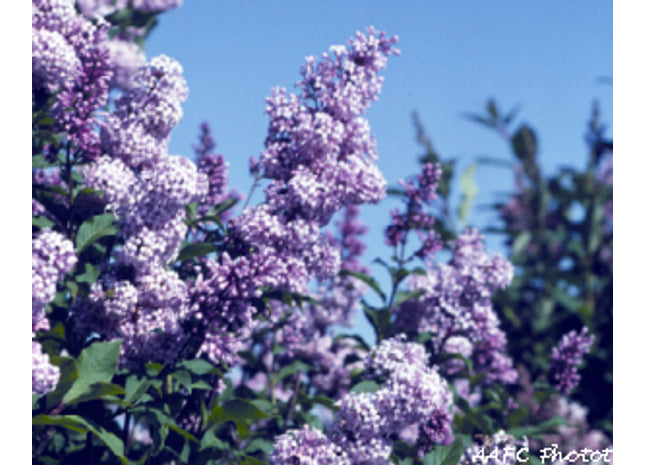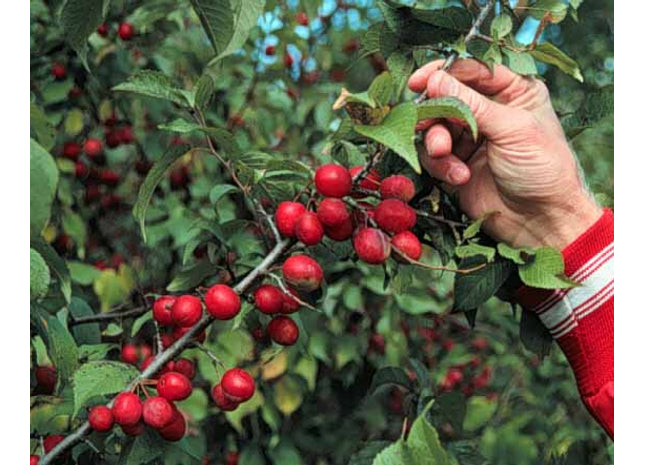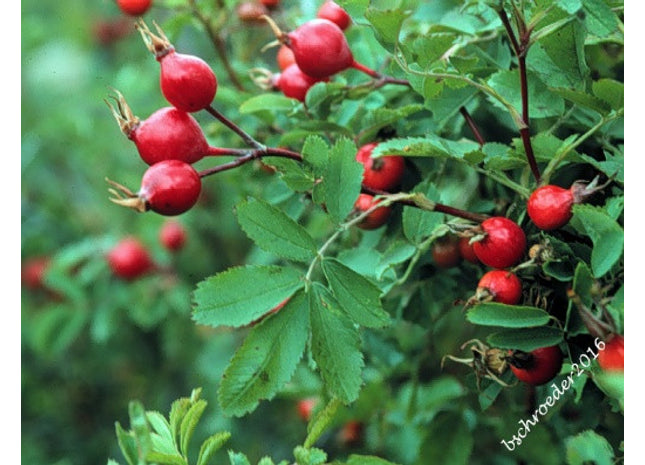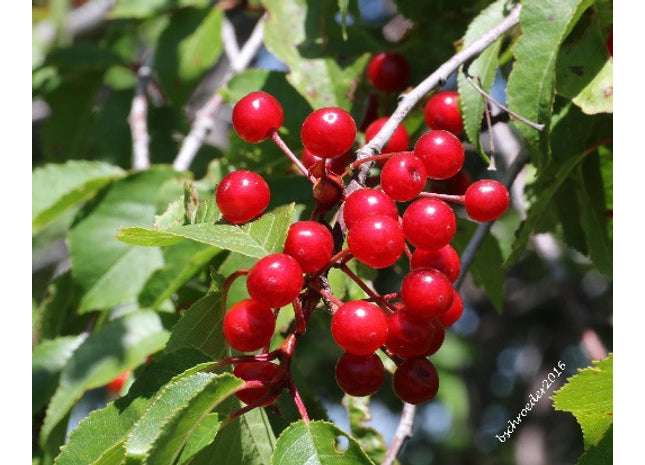Cherries

AgroForestry Solutions 'Charlie Edwards' Villosa Lilac Seed
Latin Name: Syringa villosa DESCRIPTION Family: Oleaceae Native Range: Northeastern China Seed Source: Improved seed strain, seed production orchard near Indian Head Saskatchewan. Height and Spread: 4m x 3m Overview: The seed strain was developed for tree planting in the Canadian prairies. It is a composite of parent trees from selected lilac shelterbelts. It is a medium-large, hardy shrub with an oval-shaped crown. It has basal sprouts but does not spread by suckers. It was named in honour of Charlie Edwards assistant superintendent of the Indian Head Forest Nursery Station from 1909 to 1950. Fruit: Seed ripens in a capsule in late summer. Average number of seeds/packet: 450 SEED TREATMENT / SOWING Stratification: Pre-soak seed for 24 hours then stratify in moist sand (10 percent moisture) for 60 days at 5°C. Ideal sowing time: Non-pretreated seed outdoors in September (will germinate the following spring) or stratified seed in spring. Sowing instructions: Sow 1.5 cm deep, 50 seeds/meter; Greenhouse - sow 3 seeds per cell. Growing conditions: The 'Charlie Edwards' seed strain is adapted to most soils and is hardy to zone 2. AGROFORESTRY VALUE 'Charlie Edwards' villosa lilac is used for shelterbelt and hedge planting in field and farmyard shelterbelts. The dense growth habit is well suited for providing wind and snow protection. It provides excellent cover and habitat for songbirds and small mammals. Lilac species are rated excellent for pollen availability. The attractive white/lavender blooms add fragrance and beauty to plantings.
$25.00 - $100.00

AgroForestry Solutions 'Midnight' Choke Cherry Seed
Latin Name: Prunus virginiana DESCRIPTION Family: Rosaceae Native Range: Canada and the Northern United States Seed Source: Natural stand growing near Jansen Lake, Saskatchewan. Height and Spread: 7m x 4m Overview: 'Midnight' Choke cherry is an excellent choice for agroforestry planting in cold temperate regions. This seed strain was selected many years ago by a local farmer because of its consistent production of large yields of black cherries. Fruits: Black fruit borne in clusters, 8-12 mm across. Average number of seeds/packet: 150 SEED TREATMENT / SOWING Stratification: Stratify in moist sand (10 percent moisture) for 30 days at room temperature (20°C) followed by 120 days at 5°C. Ideal sowing time: Non-pretreated seed outdoors in July (will germinate the following spring) or stratified seed in spring. Sowing instructions: Outdoor seedbed - Sow 2 cm deep and 50 seeds/meter; Greenhouse - sow 3 seeds per cell 1 cm deep. Growing conditions: Choke cherry will thrive under just about every condition imaginable, except for heavy shade. AGROFORESTRY VALUE 'Midnight' choke cherry is an excellent seed strain for field and farmstead shelterbelts, intercropping, reclamation, and wildlife habitat plantings. All plants produce fruit that can be used for berry harvest. The fruit is astringent but edible and makes excellent juice, syrup, or jelly.
$25.00

AgroForestry Solutions 'Hudson Bay' American Plum Seed
Latin Name: Prunus americana DESCRIPTION Family: Rosaceae Native Range: Native to southern Canada from Saskatchewan in the west to Quebec Seed Source: Seed production stand near Indian Head, Saskatchewan. Height and Spread: 5m x 3m (5 years) Overview: The 'Hudson Bay' American plum seed strain is adapted to cold temperate dry climates. This strain comes from a shelterbelt growing near Hudson Bay Saskatchewan. A pioneer plant quickly colonizing sites this seed strain produces bright red edible plums. Wild plum is a shrub or small tree 3-8 m tall, and usually found growing as dense thickets. Fruits: Reddish-purple oval plums 2.0-2.5 cm long containing one seed. Average number of seeds per packet - 50 SEED TREATMENT / SOWING Stratification: Pre-soak seed for 24 hours then stratify in moist sand (10 percent moisture) for 180 days at 5°C. Ideal sowing time: Non-pretreated seed outdoors in early September (will germinate the following spring) or stratified seed in spring. Sowing instructions: Outdoors - sow 2.0 cm deep, 50 seeds/meter; Greenhouse - sow 3 seeds per cell. Growing conditions: American plum grows well on a wide range of soils. As a colonizer, it will flourish on most disturbed sites. It prefers full sunlight and is considered somewhat drought tolerant and cold hardy. AGROFORESTRY VALUE American plums make good wildlife habitat and are effective in erosion control because their roots hold the soil. Their thorny branches catch tumbleweeds, leaves, and other plant materials, which, when windstorms occur during times of drought, provide an effective means of slowing wind erosion of soil.
$25.00

AgroForestry Solutions Mongolian Cherry Seed
Latin Name: Prunus fruticosa DESCRIPTION Family: Rosaceae Native Range: An introduced shrub from Asia. Seed Source: Seed production orchard near Indian Head, Saskatchewan. Height and Spread: 2m x 2m (5 years) Overview: The Mongolian cherry seed is ultra-hardy and adapted to cold temperate climates. It was developed specifically for agroforestry planting. Mongolian cherry produces high yields of edible tart cherries. The fruit is much sweeter if cooked or dried. Fruits: A round single-seeded purplish-red cherry, 1.5 cm in diameter. Average number of seeds/packet: 75 SEED TREATMENT / SOWING Stratification: Stratify in moist sand (10 percent moisture) for 120 days at 5oC. Ideal sowing time: Non-pretreated seed outdoors in late September (will germinate the following spring) or stratified seed in spring. Sowing instructions: Sow 2.0 cm deep, 50 seeds/meter; Greenhouse - sow 3 seeds per cell. Growing conditions: ’Brilliant’ Mongolian cherry grows well on medium-textured soils with soil pH 7.0 to 8.0. Agroforestry Value Mongolian Cherry is used in farmstead and field shelterbelts, Eco-Buffers, wildlife habitat, and fruit orchard plantings. Many song and game birds utilize this shrub for food and habitat. The cherries can be eaten fresh, preserved as jelly, or dried.
$20.00

AgroForestry Solutions Nanking Cherry Seed
Latin Name: Prunus tomentosa DESCRIPTION Family: Rosaceae Native Range: Northern and western China and Mongolia Seed Source: Seed production orchard near Indian Head, Saskatchewan. Height and Spread: 1.5m x 1.5m Overview: Nanking Cherry cherry is an excellent choice for fruit gardens or agroforestry planting in cold temperate regions. It also makes an attractive hedge. This seed strain was selected because of its consistent production of tangy red cherries. Cross pollination is required for fruit production so more than one plant is required. Fruits: Cherry red drupe. Average number of seeds/packet: 100 SEED TREATMENT / SOWING Stratification: Soak seeds for 24 hours then stratify in moist sand (10 percent moisture) for 100 days at 5°C. Ideal sowing time: Non-pretreated seed outdoors in late July or early August (will germinate the following spring) or stratified seed in spring. Sowing instructions: Outdoor seedbed - Sow 2 cm deep and 50 seeds/meter; Greenhouse - sow 3 seeds per cell 1 cm deep. Growing conditions: Nanking cherry is hardy and will grow in a variety of soils but will not tolerate heavy shade. AGROFORESTRY VALUE Nanking cherry is known for its fragrant pink flowers along its branches in the spring, with forest green foliage. It is a good choice for attracting birds. Both you and the wildlife will love its edible red cherries. Fruit can be tangy but is great for jams, jellies, and pies. Extremely winter hardy.
$25.00

AgroForestry Solutions 'Mackintosh' Western Sand Cherry Seed
Latin Name: Prunus besseyi DESCRIPTION Family: Rosaceae Native Range: Canada and the Northern United States Seed Source: Seed production orchard near Indian Head, Saskatchewan. Height and Spread: 1.5m x 1.5m Overview: 'Mackintosh' Western Sand Cherry cherry is an excellent choice for agroforestry planting in cold temperate regions. This seed strain was selected because of its consistent production of large yields of black cherries. It is named for Angus Mackintosh a tree inspector at the Dominion Forest Nursery Station in Indian Head from 1904 to 1916, a nature enthusiast and former employee at the PFRA Tree Nursery. Fruits: Black fruit borne in clusters, 12-15mm across. Average number of seeds/packet: 110 SEED TREATMENT / SOWING Stratification: Soak seeds for 48 hours then stratify in moist sand (10 percent moisture) for 90 days at 5°C. Ideal sowing time: Non-pretreated seed outdoors in September (will germinate the following spring) or stratified seed in spring. Sowing instructions: Outdoor seedbed - Sow 2 cm deep and 50 seeds/meter; Greenhouse - sow 3 seeds per cell 1 cm deep. Growing conditions: Western sand cherry will thrive under just about every condition imaginable, except for heavy shade. AGROFORESTRY VALUE 'Mackintosh' Western Sandcherry is known for its unique, leathery grey-green foliage and beautiful white blossoms. It is a popular ornamental shrub in parks and front yards. Both you and the wildlife will love its edible small dark red to purple cherries. Fruit can be astringent but is great for jams, jellies and pies. Extremely winter hardy. Many people graft plum and cherry varieties to Western Sand Cherry and use it as rootstock. It is also popular to graft hardy apricots too.
$20.00 - $25.00

Agroforestry Solutions 'Indian Head' Hedge Rose Seed
Latin Name: Rosa rugosa x Rosa woodsii DESCRIPTION Family: Rosaceae Native Range: Origin unknown, introduced from Europe Seed Source: Seed production orchard near Indian Head Saskatchewan. Height and Spread: 2m x 2m (25 years) Overview: `Indian Head` Hedge rose is an improved seed strain developed for tree planting in cold temperature regions. It is a small shrub suitable for agroforestry applications. The fruit is a source of Vitamin C. It has showy, pink flowers attractive to pollinators Fruits: Fruit is a hip 1.2 cm in diameter, turning fleshy and bright red when mature in late August. Average number of seeds/packet: 600 SEED TREATMENT / SOWING Stratification: Stratify in moist sand (10 percent moisture) for 90 days at 20°C followed by 120 days at 5°C. Acid scarification for 30 minutes can substitute for warm stratification Ideal sowing time: Sow 0.5 cm deep, 50 seeds/meter; Greenhouse - sow 3 seeds per cell. Sowing instructions: Sow 0.5 cm deep, 50 seeds/meter; Greenhouse - sow 3 seeds per cell. Growing conditions: 'Indian Head' hedge rose grows well on most soils except those that are excessively wet, or dry, or soils affected by high pH or salinity AGROFORESTRY VALUE 'Indian Head' hedge rose, is used in farmstead and field shelterbelts, Ecobuffers, and wildlife habitat plantings. The continuous flowering makes it attractive to pollinators. Many song and game birds utilize this shrub for food and habitat.
$25.00

AgroForestry Solutions 'Crimson' Pin Cherry
Latin Name: Prunus pensylvanica DESCRIPTION Family: Rosaceae Native Range: Native to most of the forested regions of Canada. Seed Source: Pin cherry seed block, near Indian Head Saskatchewan. Height and Spread: 6m x 3m (5 years) Overview: 'Crimson' pin cherry seed strain is adapted to cold temperate dry climates. A pioneer plant quickly colonizing sites this seed strain produces small edible tart cherries. Fruits: A round single-seeded bright red cherry. About 150 seeds. SEED TREATMENT / SOWING Stratification: Pre-soak seed for 24 hours then stratify in moist sand (10 percent moisture) for 120 days at 5°C. Ideal sowing time: Non-pretreated seed outdoors in late September (will germinate the following spring) or stratified seed in spring. Sowing instructions: Outdoors - sow 2.0 cm deep, 50 seeds/meter; Greenhouse - sow 3 seeds per cell. Growing conditions: ’Crimson’ pin cherry grows well on a wide range of soils. As a colonizer, it will flourish on most disturbed sites. It prefers full sunlight. AGROFORESTRY VALUE 'Crimson' pin cherry is used in farmstead and field shelterbelts, Ecobuffers, wildlife habitat plantings. It is an important component of multi-species Ecobuffers, nursing the seedlings of longer-lived species beneath them. Many song and game birds utilize this small tree for food and habitat. The cherries can be preserved as jelly or dried.
$20.00

Agroforestry Solutions Wood's Rose Seed
Latin Name: Rosa woodsii DESCRIPTION Family: Rosaceae Native Range: Native to the Canadian prairies Seed Source: Natural stand near Lake Margaurite, Saskatchewan. Height and Spread: 1m x 1m (25 years) Overview: Wood's rose is a small shrub suitable for agroforestry applications. The fruit is a source of Vitamin C. It has showy, pink flowers attractive to pollinators. Fruits: Fruit is a round hip 1.2 cm in diameter, turning fleshy and bright red when mature in late August. Average number of seeds/packet: 625 SEED TREATMENT / SOWING Stratification: Stratify in moist sand (10 percent moisture) for 90 days at 20°C followed by 120 days at 5°C. Acid scarification for 30 minutes can substitute for warm stratification Ideal sowing time: Non-pretreated seed outdoors in July (will germinate the following spring) or stratified seed in spring. Sowing instructions: Outdoors - sow 0.5 cm deep, 50 seeds/meter; Greenhouse - sow 3 seeds per cell. Growing conditions: Wood's rose grows well on most soils except those that are excessively wet, or dry, or soils affected by high pH or salinity AGROFORESTRY VALUE Wood's rose, is used in Ecobuffers and wildlife habitat plantings. The continuous flowering makes it attractive to pollinators. Many song and game birds utilize this shrub for food and habitat.
$25.00









